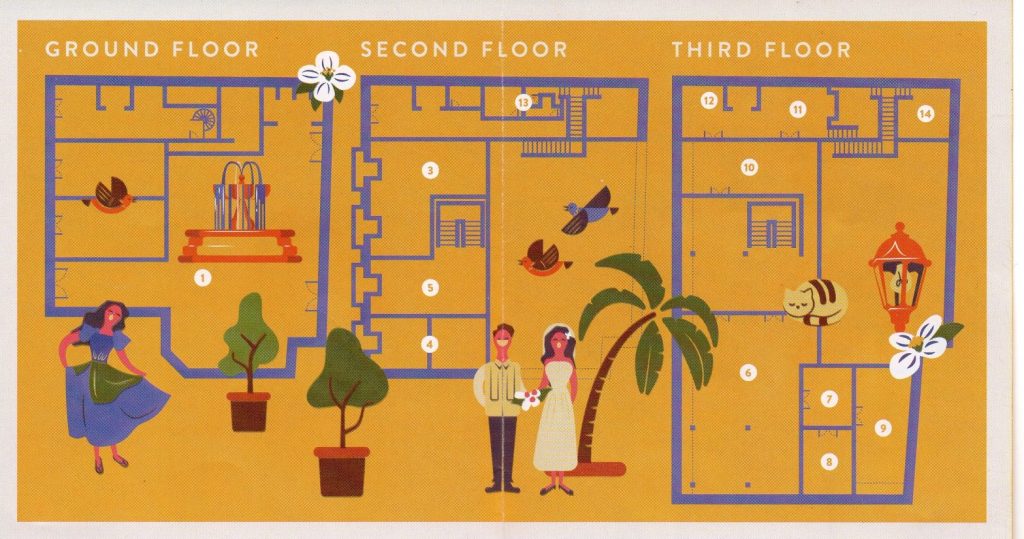
1) ZAGUAN & PATIO
It is through the zaguan that carriages entered, dropping off passengers by the stairs which lead to the entresuelo. Zaguan is an Arabic word meaning “corridor”, and is paved with granite known locally as piedra china or Chinese stones. The granite were originally ballasts from junks sold to locals by Chinese merchants. The fountain, meanwhile, is a feature that appeared after running water was introduced to Manila in 1882.
2) ENTRESUELO
Due to erciless flooding common in Manila until now, the ground floor of residences wre usually elevated . This elevated floor is known as the entresuelo, hence its root word entre and suelo, which literally means between floors. The entresuelo featres various rooms and halls, including bed chambers for guests or unmarrid extended relatives, and the office of the master of the house.
3) DESPACHO
Upper class wealth durign the colonial era was mostly sourced frrom revenue generated by mercantile business of provincial estates known localled as haciendas. The office, or where the mast of the house conducted daily business transactions relevant to this occupation.
4) CUARTOS
THe cuartos or rooms at the entrresuelo level were usually occupied by the umarried members of the extended family, or visiting guests.
5) CAIDA
The family would usually use this anteroom for parlor games, entertaining guests, or snacks.
6) SALA
Very important guests were received in the sala. This room therefore fisplays the finest furniture in the house, showing off the family’s opulence and status. Afternoon soirees, known as tertulias, and traditional dance parties were hel here. Tertulias had the young ladies of the household play music or sing. Other times, the elders would discuss the latest in politics, business, and fashion.
7) ORATORIO
The household would gather in this prayer room to pray the angelus or the rosary. Religious images, known as santos, especially if made of ivory, were important status symbols. Processional images, which were bought out for processions on carrozas or floats are kept in this room inside their respective urnas or protective cases.
8) BLUE ROOM
The wall paintings in this room were taken from Pompeiian motifs which influenced the neo-classical style. This style began in Europe during the late 18th Century and influenced Philippine art nad architecture from the early 19th Century onwards. A door links the Blue Room to teh Cuarto Principal.
9) CUARTO PRINCIPALl
The Cuarto Principal was the bedchamber of the master of hte house. It features of the finest furniture, including an aparador de tres lunas (armoire with three sections), a tremor (dresser with swinging full-length mirror), and a marble lavabo (wash stand). Local customs dictated that, as an act of hospitality, the master of the house would offer his room to important guests stating overnight.
10) COMEDOR
The walls of the dining room were often lined with plateras (sideboards) to display the familiy’s porcelain, silver and glassware. Ceramic plates often decorated the walls.
Except for the frame, the dining table is made from a single plank of narra wood.
The punkah, a manually operated ceiling fan, must have been bought from India during the British occupation of 1762. The punkah not only cooled the dining room; it also shooed the flies away.
11) COCINA
The kitchen is loaded with functional features. The stovetop is made of ash and water. The paminggalan (cupboard) was used to store preserves and leftovers. A can of kerosene was sometimes placed under each leg to prevent ants from going up. Protruding outside the windows was banggera where dishes were washed and dried upside-down on wooden spikes.
12) LETRINA
The letrina is good for two and simulates a late 19th century toilet found in the affluent homes. This was a novel facility when indoor plumbing was still new. Flushing meant throwing large buckets of water down the tubes, which were connected tothe nearest river.
13) BAÑO
The bathroom contains two large stoneware tubs. The master would sit in the tub while servants poured water. The tubs featured here are imported Ming Dynasty stoneware pieces.
14) AZOTEA
The azotea serves many purposes. The aljibe or water cistern that supplies water to the household is located here. Any activity requiring large amounts of water was done near the aljibe. Laundry, gardening, as well as butchering pigs or chicken for family meals were done in the azotea. One might have a well, instead of the aljibe.
Rainwater from the roof gutters was collected through the stone column — which led to the filter of charcoal, gravel and sand — and then to the cistern.
Various herbs used for cooking are grown in the azotea. For instance, leaves of the tanlad or lemon grass were used for roast pig and boiled chicken or sinigang. Pandan, a type of palm, sweetens the aroma of boiled rice.
Existing plans of late 19th century Manila houses mostly had bathrooms. Otherwise, people may have bathed on the azotea as practiced in the countryside.
